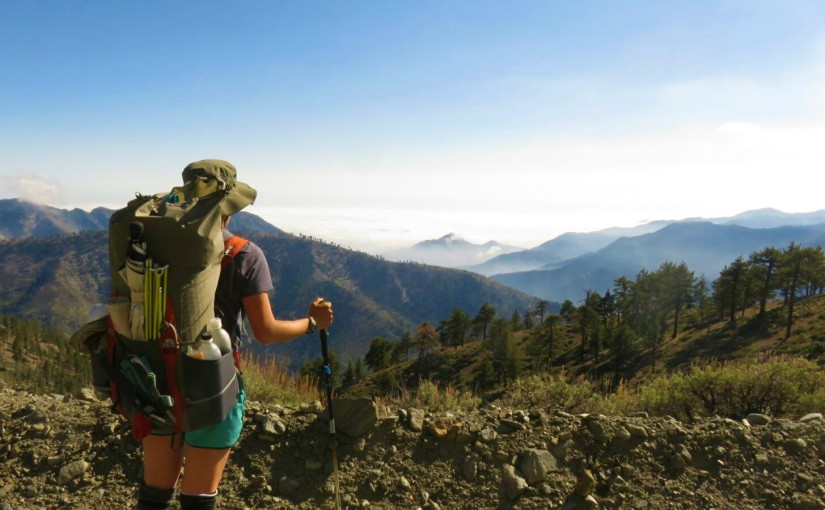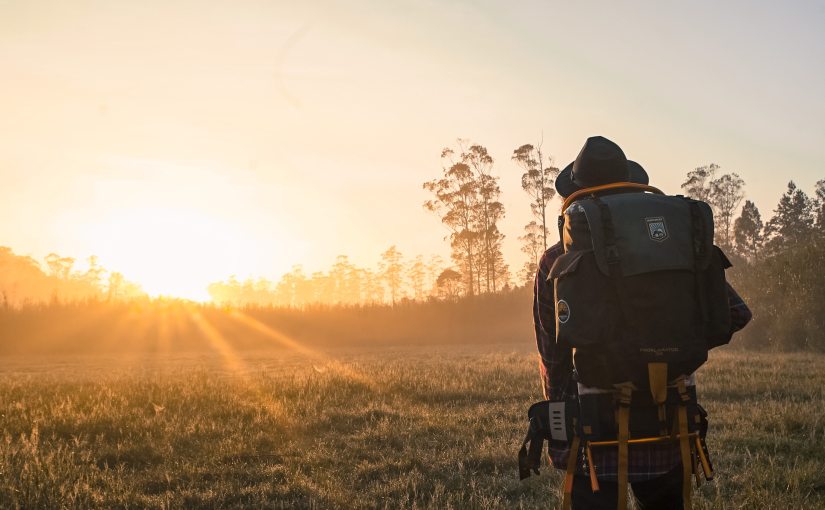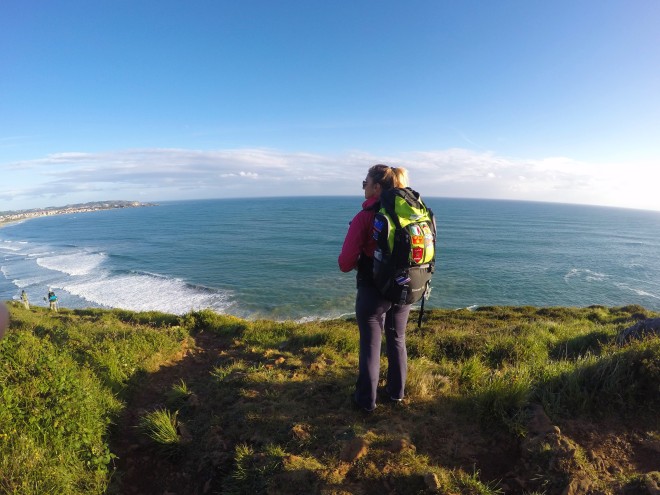The report of the young lady that completed the 2650 miles route on the Pacific Crest Trail and how it changed her concept of substantiality after a five-month journey in wild nature
Once we’ve chosen a path, it’s often common to feel uncertain if we are making the right choice. For example, have you thought of putting everything aside in order to search for a new meaning to your life? Our “sem fronteiras” today has and she seems to be habituated with transitions. 18 years ago, her family left everything in Argentina and moved to the US due to her father’s job. On the day of her wedding, during the speech, her father said that when she was a child, they used to spend their vacation on the coast of Argentina, and, when she was learning to take her first steps, she feared touching her feet in the sand of the beach. What he didn’t know is that later, those same feet would be the support of the brave woman she had become, and who crossed from end to end the country that is now hers. Yes, she crossed the United States on foot, all the way from Mexico to Canada, by the Pacific coast – on the Pacific Crest Trail. If you’ve ever watched or read “Wild” by Cheryl Strayed, we are talking about that same route. It took 5 months and 3 days, 2650 miles (4265 km) traveled, 5 pairs of sneakers and an incredible story to tell – this is the story of Silvina Kotlarek, 28 years old. Want to know how this happened? She’ll tell you!
When was the last time I ran freely?
Trying to escape the stressful environment of the office where she worked, Silvina stared out the window of the skyscraper as if she could get out of the chaos of New York and her busy life, inside and outside of the buildings. She knew she wanted to change something, but she had no idea where to go nor what to do. “I needed a break and a way to connect with my inner self, to think internally and to process about where I was in life and what I wanted to do with it”, said the young woman, who at the time, was 26 and worked in the financial sector of a major international bank, in the biggest city of the United States.
Like in Clarissa Pinkola Estés’s book “Women Who Run with the Wolves,” Silvina asked herself the question: When was the last time I ran freely? Wrapped in a new perspective for her life, she and her boyfriend, with whom she is married today, decided to sell everything they had, to quit their jobs and to take a long backpacking hike through the wilderness.
“We started hiking in April and finished at the end of September 2016. The Pacific Crest Trail is incredible. We crossed the Mojave Desert in southern California, the Sierra Nevada mountains, the dense forests in Oregon and the North Cascade mountains in Washington. It was definitely one of the most beautiful and rewarding things I’ve ever done.” Said Silvina.
Pacific Crest Trail… here I go!
The young lady said that the planning lasted almost a whole year, but that it was very interesting, because she and her boyfriend dedicated several hours of the day to study the route. “It’s very easy to find excuses and leave everything for the next year, but it’s extremely important to live life ‘now’. So the first thing we did was look for all the equipment we needed and calculate the distances, how many miles a day we would make, how much time we would spend between each pause for supplies, how much food we would need, and how much money would be needed for every month. Each of us read several books about how to hike long distances, which gave us a sense about all difficulties as a physical and mental challenge” said the backpacker with excitement.
The starting point of the Pacific Crest Trail is in the town of Campo, California, literally on the border of Mexico, right next to the wall that divides the border. Silvina recounts that she had difficulties in the beginning, even though she had trained a lot before.
“In the beginning, we walked an average of 18 miles (29 km) a day, but then, when our legs became stronger and our bodies could withstand more, we started to do 26 miles (41 km) a day, relatively a lot. Our record was 30 miles (48km) a day, and it was not easy for our physique to adjust. But when it did, I felt super good, healthy and strong, I saw how our bodies are ready to adapt to the environment and to the situation in which we put them in” she points out, happy with her development.
All of the material she owned was on her back. “It’s very beautiful to experience the simplicity in which one can live. We had a small tent, a light and simple stove, and every night we prepared the tent, cooked and went to sleep, because we were very tired. The next day we would pick up all our belongings and continue the journey into the night. Every 100 miles we had to replenish our food, and every 500 we had a change of sneakers, because they were totally destroyed. My mother-in-law would send us packages to the collection stations we passed with everything we needed, such as bandages, supplies, and sometimes new clothes. As we had planned for a long time, we left everything ready so that she just needed to post the packages” she said, remembering that nothing would be possible without the help of loved ones over those five months.
The Trail Angels
According to Silvina, the most wonderful thing about the Pacific Crest Trail is what they call “Trail Angels”. They are people who do volunteer work all the time for backpackers. “Sometimes on the trail we’d see a cooler with some diet coke and candy they’d leave for us, that’s when we’d take a break. Several times we found places with barbecue, food and drinks, with everyone gathered around enjoying each other’s company. There were also people who let us spend the night in their homes. We met a lot of amazing people, all with a common connection. There were also the backpackers who finished the trail before us and were waiting for us with food, drink, and clean socks. It was truly magic to connect with the community around this track. This was all so inspiring that we’ve done the same. When we finished the route on the edge of Canada, we returned to the trail and took a bag with some candy, donuts, soda and fresh water. It’s great to live this experience together again’, she said.
The lesson of nature and its simplicity
Silvina said that stopping to enjoy the simple things of life was the greatest legacy of this adventure.
“The most impressive is nature with its charm. I wanted to take a break and find inner peace with meditation, but I was completely amazed with all the beauty we had and how easy it is to forget about it when we’re working indoors every day. It’s really important to take a break and enjoy the experience of the nature that surrounds us. In addition, I began to give more value to the simple things. In everyday life, we have a lot of materialism around us, many things that are superfluous. After this trip, we moved to a different city and now we live in a very simple apartment, not too extravagant, but it makes us happy. You don’t need all the extra things that society pushes us through. Now, whenever I need to buy something, I choose the item not for it being greater or better, but for it being enough”, she says, proud of her personal evolution.
For Silvina, hiking the trail with the person she loves the most in the world was a gift, and she advises women who want to make the journey but fears for not having company, to do so alone, because during the summer, thousands of people hike the same path. “It’s always good to push yourself out of your comfort zone because you learn a lot about who you are and about something you would normally not experience. So I recommend is: try something new, don’t let society hold you back. Wherever you go, in any country you are, there will always be a trial in wilderness to be hiked and it will be incredible. You learn a lot about yourself, about your body and your mind”, she concludes.
After crossing a country on foot and going through deserts, mountain ranges and forests, the girl might not have even been afraid when she was small and reluctant to put her feet in the sand. Probably she was simply making a choice, like later, the one that would awaken her to the excesses of society. Perhaps Silvina would only have to cross the desert and see what laid in it, thus transforming herself into the strong and free woman who crosses mountains.
We authorize the reproduction of all our articles under the condition that the active link to the original document of Elas Sem Fronteiras is published together ♥️.





















